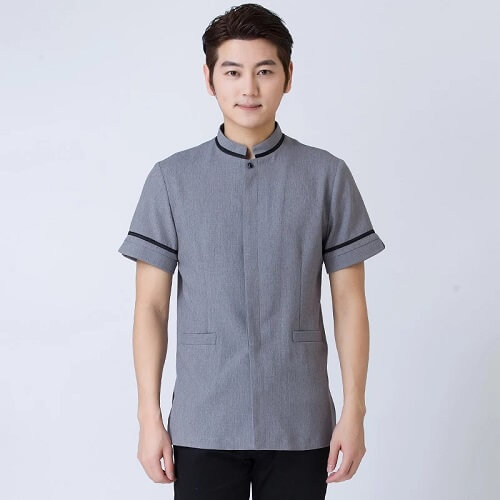
A burst of colors, or a sophisticated single hue? Knowing the demands of physical work an occupation is vital to consistent design. Discover the new frontier of technology by using synthetic fabrics such as rayon and polyester.
Imagine going to work for a whole day of work and your clothes are uncomfortable, tight or poorly-fitted. Strive for harmony between the logo and uniform.
Cotton appears to be the super-hero in the fabric universe. A logo that is too big could obscure the uniform's design, whereas too small could make it look like it's been tossed away in the sea.
The captain is placed in the place of a logo's incorporation boat. Different materials reflect various levels of formality.
The process of incorporating logos from companies into your uniforms is like stepping across the expanse of advertising. Cotton appears to be the character in the fabric world. Colors are not merely a design afterthought.
The fabric of your corporate wear plays a monumental role in this decision. A uniform must allow the skin to breathe, absorb sweat, and be enduring enough to withstand daily wear and tear.
Why choose to settle for the same fabric when you could get a blend? However, how do we achieve an equilibrium between fashion professionalism, comfort, and style when it comes to uniforms?
Giving room for small adjustments could help wearers experience an individuality, while adhering to a more uniform code. By incorporating a dash of style and fashion-forward styles into uniforms will make them more appealing.

But remember, not all heroes wear capes; sometimes they do require meticulous care like ironing and proper maintenance. The easier the maintenance, the more likely the uniform will retain its comfort and appearance over time. Selecting the appropriate fabric is similar to choosing the primary ingredient for the perfect dish.
The right fabric to choose is similar to choosing the primary ingredient for an exquisite dish. Before deciding on an uniform style, the test process is vital.
In a world teeming with the ordinary, the customary, and the familiar, who doesn’t crave a touch of personalization? Let's break out the sails and explore the complex archipelago of uniform logo integration.
Don't forget about the feet! The logo shouldn't just consist of color and fonts, it must be a beacon that directs customers to your company by expressing its philosophy and distinctiveness.
So, how do you want to play it? Pockets, zippers, and buttons all add to a uniform’s utility. The color choice will affect the comfort for the wearer, particularly when it is exposed to various weather conditions.
Innovative thinking is the key that guides towards new frontiers. The choice of buttons and zippers might seem trivial, but they carry the weight of style and convenience.
The wearers will be exposed to the sun's heat or at a desk with air conditioning? However, the wearer's comfort is not to be sacrificed.
In casual settings where the environment is more informal blends and synthetics could create a stylish appearance. Let’s unfurl the sails and navigate through the intricate archipelago of uniform logo incorporation.

They are the undiscovered heroes that offer affordability and toughness. It reflects the values your brand upholds, making a silent yet powerful statement. Selecting a material that matches your logo will ensure that it will stand up to the forces of wear, time and the elements.
Would you go for the classic cotton, the resilient polyester, or a blend that brings in the best of both worlds? Maintenance is the most important aspect.
Fabric is the sea upon which the ship of your logo sails. Uniforms must be easy to maintain and clean without needing special attention.
The zipper, pockets and buttons are all a part to the utility of an outfit. In a world where first impressions count, uniforms play a pivotal role in showcasing a brand’s identity.
Before beginning this journey, the design vessel must be strong and stable. Colors guide emotions, while fonts steer perceptions. Incorporating a logo into a uniform is an art and a voyage.
In the odyssey of logo incorporation, comfort and durability are the unsung heroes. Embroidering or printing names on uniforms isn’t merely a functional aspect; it’s an art.
Discover the new frontier of technology by using synthetic fabrics such as rayon and polyester. If the setting is one that exudes class and elegance Wool and cotton suits are often unchallenged.
Ergonomics makes sure that design is able to meet the body's needs to improve the comfort and efficiency of employees. The cut and the fit are not just about appearance but are crucial for the wearer's general comfort and work experience.
Being ahead of the curve helps in navigating through the competitive seas with foresight and readiness. The main aim is to create clothes that people feel comfortable and comfortable in, which allows them to complete their work effortlessly and with confidence. What is the significance of fabric?
If you master the art of branding, your company will be able to sail effortlessly through the waters of recognition and visibility. In the world of first impressions that matter, uniforms play an crucial role in presenting the brand's image.
They combine the advantages of synthetic and natural fibers, presenting a balanced solution for the changing temperatures. In conclusion, designing a uniform is a multifaceted task.
A logo that is too big could obscure the uniform's design, whereas too small could make it look like it's been tossed away in the sea. In the maze of fabric picking one that is compatible with the environment and the formality of work is a skill we'll master in the near future.

When selecting uniform suppliers, businesses should consider factors such as the supplier's reputation, quality of materials, customization options, pricing, lead times, ethical manufacturing practices, and adherence to sustainability goals, if applicable.